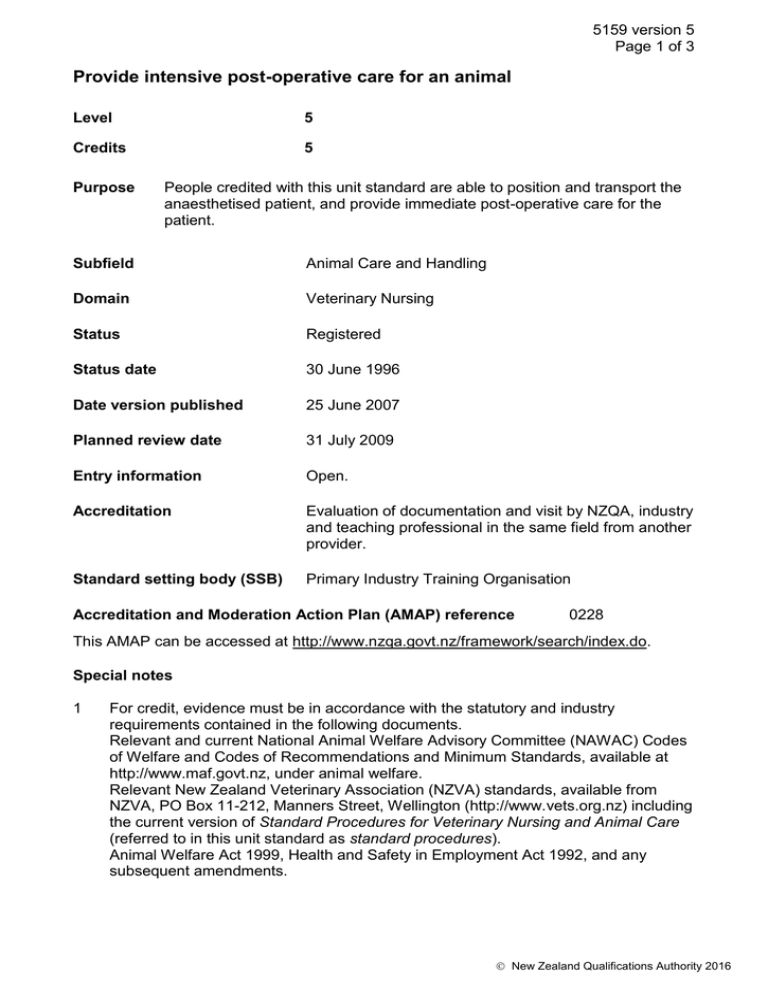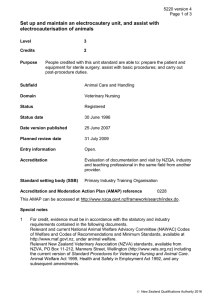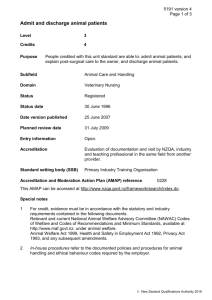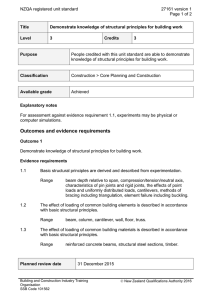Provide intensive post-operative care for an animal
advertisement

5159 version 5 Page 1 of 3 Provide intensive post-operative care for an animal Level 5 Credits 5 Purpose People credited with this unit standard are able to position and transport the anaesthetised patient, and provide immediate post-operative care for the patient. Subfield Animal Care and Handling Domain Veterinary Nursing Status Registered Status date 30 June 1996 Date version published 25 June 2007 Planned review date 31 July 2009 Entry information Open. Accreditation Evaluation of documentation and visit by NZQA, industry and teaching professional in the same field from another provider. Standard setting body (SSB) Primary Industry Training Organisation Accreditation and Moderation Action Plan (AMAP) reference 0228 This AMAP can be accessed at http://www.nzqa.govt.nz/framework/search/index.do. Special notes 1 For credit, evidence must be in accordance with the statutory and industry requirements contained in the following documents. Relevant and current National Animal Welfare Advisory Committee (NAWAC) Codes of Welfare and Codes of Recommendations and Minimum Standards, available at http://www.maf.govt.nz, under animal welfare. Relevant New Zealand Veterinary Association (NZVA) standards, available from NZVA, PO Box 11-212, Manners Street, Wellington (http://www.vets.org.nz) including the current version of Standard Procedures for Veterinary Nursing and Animal Care (referred to in this unit standard as standard procedures). Animal Welfare Act 1999, Health and Safety in Employment Act 1992, and any subsequent amendments. New Zealand Qualifications Authority 2016 5159 version 5 Page 2 of 3 2 In-house procedures refer to the documented policies and procedures for animal handling and ethical behaviour codes required by the employer. 3 Underpinning Knowledge The following areas of knowledge underpin performance of the elements in this unit standard: element 2 Reasons for indwelling catheters Common catheters in use Reason for drains, common types in use Maintenance of intravenous drip lines and cannulae Dangers of excess/deficiency of fluids Normal recovery appearance and behaviour Causes and signs of shock. Elements and performance criteria Element 1 Position and transport the recently anaesthetised patient. Performance criteria 1.1 The patient is positioned for transport to ensure it can be observed while being transported. 1.2 The patient is transported with minimum stress or trauma and without compromising surgery. Range maintain airway, protect wounds, maintain body temperature, maintain indwelling catheters and fluid therapy, monitor vital signs, maintain patient comfort. Element 2 Provide immediate post-operative care for the patient. Performance criteria 2.1 Patient is placed in an environment which is conducive to recovery. Range 2.2 appropriate environmental and body temperature, noise level, easily observed, suitable bedding, suitable positioning. Post-operative patient is monitored, and vital signs are recorded according to standard procedures. Range respiration, pulse, temperature, mucous membranes, fluid intake/output, wound care, apparent pain responses, defecation, urination, vomiting. New Zealand Qualifications Authority 2016 5159 version 5 Page 3 of 3 2.3 Support therapies are maintained according to standard procedures, and recorded according to in-house procedures. Range 2.4 Complications are recognised, reported immediately to the veterinarian according to in-house procedures, or acted on in the best interests of the animal in the event of the veterinarian being unavailable. Range 2.5 fluid units, indwelling catheters, drains, nursing care (turning of recumbent patient), medications, application of local heat or cold, dressings, bandages. pain, drug reactions, haemorrhage, shock, hypothermia, hyperthermia, vomiting, respiratory obstruction or difficulties, dislodgement of catheters/cannulae/dressings/drains, faecal and urinary abnormalities. Actions are recorded according to in-house procedures. Please note Providers must be accredited by NZQA, or an inter-institutional body with delegated authority for quality assurance, before they can report credits from assessment against unit standards or deliver courses of study leading to that assessment. Industry Training Organisations must be accredited by NZQA before they can register credits from assessment against unit standards. Accredited providers and Industry Training Organisations assessing against unit standards must engage with the moderation system that applies to those standards. Accreditation requirements and an outline of the moderation system that applies to this standard are outlined in the Accreditation and Moderation Action Plan (AMAP). The AMAP also includes useful information about special requirements for organisations wishing to develop education and training programmes, such as minimum qualifications for tutors and assessors, and special resource requirements. Comments on this unit standard Please contact the Primary Industry Training Organisation standards@primaryito.ac.nz if you wish to suggest changes to the content of this unit standard. New Zealand Qualifications Authority 2016






